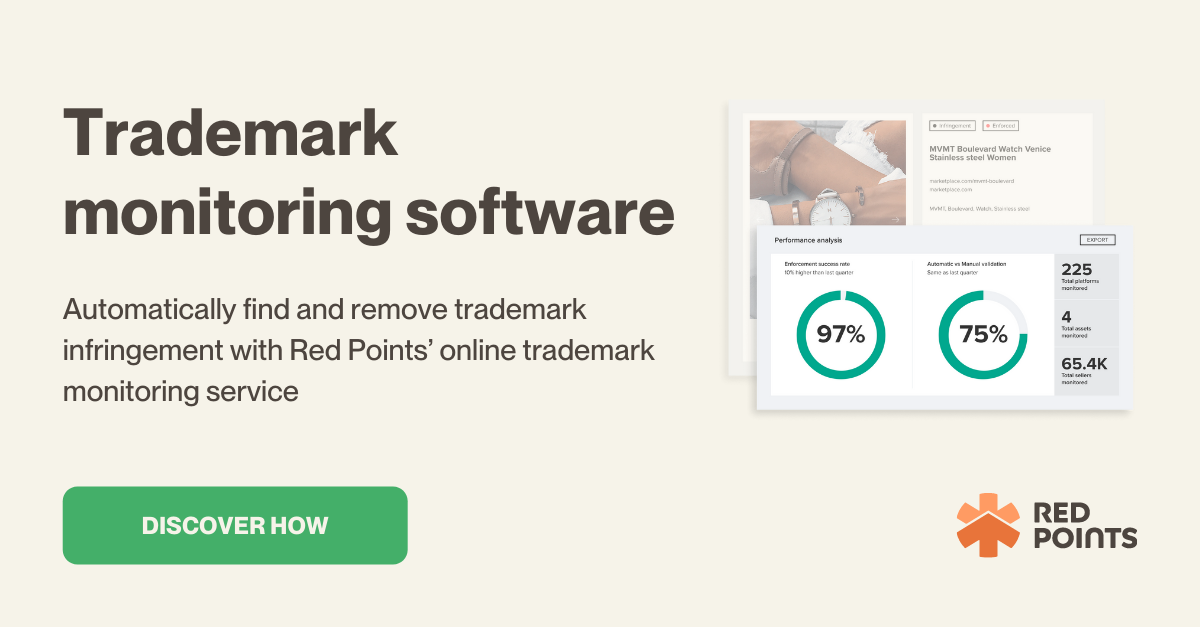The global value of counterfeiting, including digital piracy, is over $2 trillion. Every day bad actors are finding new ways to take advantage of brands and customers online. One of the key issues is the misuse of intellectual property(IP), particularly trademarks.
Trademark counterfeiting threats are a real problem for many brands today who are struggling to detect, monitor and take down scammers intent on misusing their IP. The best way to counteract these threats is to be informed and proactive. It is important to learn about the various types of trademark counterfeiting as well as the most effective ways to combat these counterfeiters.
In this blog, we’ll be exploring the top trademark counterfeiting threats and how to counteract them by highlighting a few key topics, including:
- What is trademark counterfeiting?
- Common examples of trademark counterfeiting
- Impact of trademark counterfeiting on brands
- How to detect and shut down trademark counterfeiting
- How Red Points Brand Protection Solution can safeguard brands against trademark counterfeiting and recover revenue lost to bad actors.
What is trademark counterfeiting?
Trademark counterfeiting is when a registered trademark is placed on a product or used for a service that is not connected or does not belong to the original trademark owner. Scammers use trademark counterfeiting to pass off dodgy goods as legitimate and trick consumers into believing they are purchasing the real thing.
In the United States, the Lanham Act prohibits this kind of counterfeiting and seeks to protect the trademark owner as well as the consumer. In recent years, trademark counterfeiting litigation has had to evolve with the advent of digital piracy and the use of the internet to accomplish fast, widespread, and effective trademark counterfeiting.
Common examples of trademark counterfeiting
Trademark counterfeiting is often associated with certain types of goods such as:
- Jewelry: Trademark counterfeiters will use cheap materials to replicate recognizable necklaces, earrings, bracelets, and rings that bear signs, logos, symbols, and other visual elements associated with popular jewelry brands.
- Electronics: Counterfeiters commonly replicate popular electronic products such as smartphones, tablets, headphones, game consoles, and chargers, using the trademarks of well-known or smaller brands to trick unwitting consumers.
- Clothing: Trademark counterfeiting is extremely prevalent in the clothing industry because counterfeits can be easily created by copying a brand’s logo, its name, and the overall look of the clothing item. Shoes, shirts, dresses, coats, and skirts, are all subject to counterfeiting by fraudsters looking to make quick money through cheap production and trademark theft.
- Fashion Accessories: Purses, handbags, scarves, belts, sunglasses, watches, and many more accessories are all frequently targeted by trademark counterfeiters. Bad actors will reproduce these items with cheaper materials and pass off their versions as legitimate by using the logos, designs, and names of real brands.
If a brand logo or sign plays a large role in the decision-making process of the buyer then some scammer will likely have tried to take advantage of this by misusing a legitimate brand’s trademarks. For example, the Nike Swoosh or Air Jordan sneaker derives a tremendous amount of value from their recognizable trademarked design.
Counterfeit versions of these kinds of products can be made quite easily at inexpensive rates. This means they are often the target of trademark counterfeiters who are looking to make some easy money as fast as possible. Online marketplaces and websites have made it even easier to market and sell these illegitimate products straight to the consumer without a middleman.

Impact of trademark counterfeiting on brands
- Loss of sales
The most immediate impact is that your business will suffer from a loss of sales. If counterfeit versions of your trademarked goods and services are on the market they will undercut the sales of your legitimate versions.
Often trademark counterfeits will produce inferior versions of your product and they will be able to sell them at a lower price. If consumers are not too concerned about the legitimacy of the product or if they are simply confused, then they will end up buying the counterfeit version rather than yours. This trademark infringement will potentially result in the loss of sales and may significantly damage your business’s growth prospects.
- Reputation decline
Trademark counterfeiting will also impact the way your brand is perceived by consumers, stakeholders, and competitors. For example, if a counterfeit version of your product fails to work or falls apart, the customer might end up blaming your company for the inferior product made by the counterfeiter.
Over time, incidents like this will build and customers will start leaving negative reviews online. Your brand’s reputation will decline in the eyes of your online community and this may have a knock-on effect on your ability to market and sell new products and services online.
- Protection and recovery costs
Combating trademark counterfeiting online on your own will cost you time and money. For those unfamiliar with trademark counterfeiting litigation and protecting trademarks from counterfeiting, it can be a complex and time-consuming area.
The protection and recovery costs will mount, especially if you are attempting to tackle the issue alone. You will have to pull resources away from product development or advertising and this will impact the whole of your brand.
How to detect and shut down trademark counterfeiting
- Manual monitoring
To detect and shut down trademark counterfeiting you can start manually monitoring key marketplaces. Learn where counterfeit versions of your products are being sold and use the search function within these marketplaces to identify the bad actors.
Whilst a good starting point, it is worth noting that this is an extremely time-consuming process, that isn´t scalable in the long run, especially for brands experiencing a high volume of infringements.
- Leveraging a trademark monitoring solution
You can also leverage a trademark monitoring solution like Red Points’ Brand Protection Software. This solution will help you find, track, and remove counterfeit listings of your trademarks with speed and precision.
With our automated counterfeiting protection software you will be able to more efficiently and cost-effectively safeguard your products from bad actors. This means you will be able to protect your customers and your revenue as well as the value of your intellectual property rights. It is the ideal solution to an increasingly digital dilemma.
- Send cease and desist letters
Serving cease and desist letters to individuals or entities you suspect are engaged in trademark counterfeiting can help shut down trademark counterfeiting. These letters notify the offenders of their rights and demand that they stop selling counterfeit goods immediately.
- Collaborate with online platforms
Reaching out to e-commerce platforms, social media sites, and other online marketplaces where counterfeit products are being sold can go a long way. Most of them have policies in place to address counterfeiting and can take down infringing listings. Check out our Youtube channels for tutorials on how to take down counterfeiters on major social media platforms and marketplaces worldwide.
- Take legal action against counterfeit goods sellers
Red Points’ Revenue Recovery Program can help you take successful and cost-effective legal action against counterfeits. Our program works on a contingency basis, ensuring that you are never liable for fees, whatever the outcome may be. We and our trusted legal partners will only receive a percentage of the awarded damages if you are successful in your counterfeit lawsuit.
- Conduct raids and seizures
In partnership with law enforcement, in order to address trademark counterfeiting in a more aggressive manner, brands can look at conducting raids at locations suspected of producing or selling counterfeit goods. Seizures of counterfeit products can be a deterrent to further infringement. This is a strategy that the Senior Brand Protection Director, John Carriero, at Under Armour implemented successfully. Listen to his experience in our Heroes of Brand Protection podcast.
How Red Points Brand Protection Solution can safeguard brands against trademark counterfeiting
- Visibility: Our solution massively expands your visibility of trademark counterfeiters online. Over 900 brands use our advanced counterfeiting software, in part, because it provides a transparent and in-depth view of the counterfeit market. This increased visibility will help you make crucial decisions to ensure that you can combat trademark counterfeiting at the source.
- Detections: Our machine learning artificial intelligence (AI) platform uses smart bots to quickly detect and catalog potential cases of infringement. We can accomplish a week’s worth of manual detecting work within minutes. In addition, the machine learning software ensures that each search is targeted and precise.
- Automation: The system of automation we run within our solution allows us to work quickly and effectively. Once we have identified potential infringements and place them in a log you will then be responsible for reviewing this list. However, we also have smart tools in place to allow you to automate this process based on specific guidelines that you can set up at the start.
- Litigation compensatory damages: Red Points’ Revenue Recovery Program is a free supplement that will allow you to automate the legal process to ensure that you can hold trademark counterfeiters financially accountable for their damages.
What’s next
Trademark counterfeiting online is a growing problem for businesses. Bad actors are constantly finding new ways to take advantage of legitimate IP, undercut brand revenue and mislead consumers. This issue is particularly prevalent in the fashion, jewelry and electronics industries, where recognizable trademarks have a significant influence on consumer behavior.
Red Points’ Brand Protection Software is the ideal solution to allow you to proactively counteract any trademark counterfeiting threats. Our software increases your brand’s visibility of the market for counterfeits and enables you to efficiently detect potentially damaging trademark counterfeiters. Then you are empowered to pursue these bad actors, remove them from the online world and recover your revenue.
To learn more about how Red Points can help your business combat counterfeiting threats with a top brand protection solution, please request a demo here.







